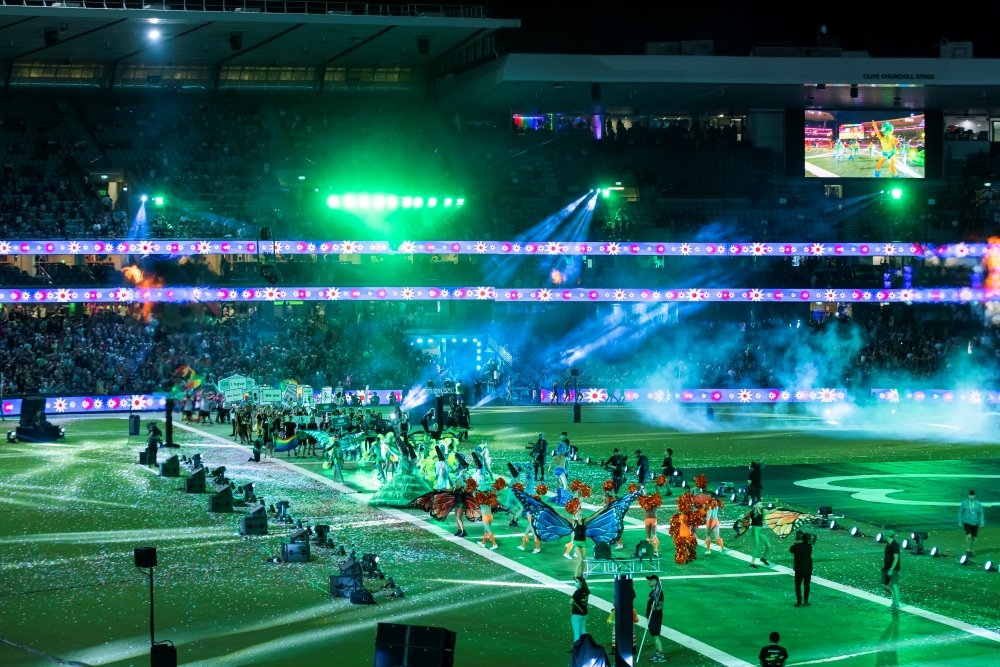News
7 Apr 2021
Sydney Gay and Lesbian Mardi Gras Parade 2021

Subscribe to CX E-News
Having worked on Mardi Gras’ final night parties for 16 years, Richard Neville, owner of Mandylights, found himself in the middle of re-imagining the iconic Parade for the COVID era. With restrictions constantly changing, the traditional parade route and packed crowds were out, and solutions had to be found to keep the historic and politically important event alive. Time to get creative…
(lead image – photo by Rocket Weijers)
“The Parade usually starts at Hyde Park, works through Oxford Street, and ends up at The Entertainment Quarter in Moore Park,” outlines Richard. “The final night party then happens at the Royal Hall of Industries and the Hordern Pavilion. With circumstances constantly changing in 2020, we weren’t sure there was even going to be a parade or a party. Around October 2020, the organisers started talking about the concept of re-locating the parade, cherry-picking the major elements of the party, and combining them into a COVID-safe event.”
In a stroke of creative genius, the Sydney Cricket Ground, adjacent to the traditional party venues in Moore Park, was put forward as a solution. “Using the SCG like this was legitimately unprecedented,” explains Richard. “The venue had never hosted anything remotely similar, save for a U2 concert years ago. They had never had a full lighting rig brought in or field-of-play audio to that scale, let alone a parade. There are basically no rigging positions, and no physical consistency; the stands vary in age from 120 years to 20. You can’t hang trusses, and because every stand is different, it wouldn’t really help if you could. Huge sections of the venue are heritage listed, including the turf. There are so many areas where we couldn’t put any equipment or have anyone walk.”

The creative concept was to take elements of the party, like headline performances, and incorporate them into the Parade, in a completely live event for 37,000 people in the stadium, overlayed with a broadcast component. “It was a mammoth undertaking to completely redo the concept of a politically charged parade. The Mardi Gras Parade started as a political protest in 1978, and there was a strong desire to be as true to the original concept as possible. Mardi Gras is still a community organisation, and the organisers wanted to keep ticket prices between $5 and $20 dollars, so we definitely did not have the budget of a typical $100 dollar-a-ticket stadium gig. So how do we produce a stadium-level event but keep prices down to remain accessible? Remember, the Parade is usually free on the street. It was a difficult set of circumstances, then add to that changing requirements due to COVID, and the partial lockdown over Christmas. One minute we were allowed to run at full capacity, next it was half, and we finally ended up at 75 percent.”
In terms of lighting, the brief was simple yet complex: light everything. With the Parade route around and through the stadium the best part of 750 metres long, a stage at either end, and a requirement for total coverage of the ground and seating, Mandylights had their work cut out for them. “The Parade route came in at one end of the SCG, did a full 360, then marched across the centre of the ground for what is normally the ‘Taylor Square Moment’ that the broadcast focuses on,” continues Richard. “Any headline performer on either stage could jump down and perform anywhere on the stadium floor. TV needed to see the crowd. And this was on a budget that was a fraction of what the NRL or AFL might spend on a half-time or pre-game show.”

The key to success was organisation. Mardi Gras got the creatives, producers, designers, production and broadcasters together very early in the process, all working together to ensure maximum efficiency. “Getting everyone engaged so early meant we were all on the same page about what we could and couldn’t achieve,” agrees Richard. “Everyone ended up working together to get a perfect mix of lighting, audio, pyro, and everything else we needed to support the event.”
“From a lighting point of view, the SCG were incredible through the whole process,” adds Richard. “We spent a whole night flicking between different levels of the stadium lighting, and worked out that the lighting we would bring in would be an overlay to the lowest level of the stadium lights. At their lowest setting, we were just under where we needed to be for white light for camera. Then it was about layering as much high-power lighting over the top of that for effect. We then found 30 positions in the audience in various crossover aisles where we could put ‘pods’ of lights with power and network infrastructure installed specifically for the event. Each pod comprised two beams and a high-powered LED flood. We also had follow-spot positions in the stands.”

With a huge paying crowd to please as well as the TV audience, Richard and Mandylights had to ensure everyone got their money’s worth. “We needed to play to 360 degrees, so if you’ve paid to see a headline performer, you get to see them and not the back end of their stage. The decision was made early on to build two stages at opposite ends of the stadium and alternate the content. We didn’t want to create an experience that made it feel like we were only playing to one part of the stadium. The stages were identical and kept open, free of as much tech stuff as possible to allow the performers to perform to the entire crowd.”
Both stages were built by Stagekings, with production pits run around their perimeters. Footlights were hidden in the pits, along with audio. A thin LED feature ran on the upstage wall that could be both seen and filmed through. “We were able to get some good looks, lots of smoke, local footlights, eye-candy LED around the stage, and fill in the front from the moving lights,” Richard reports. “The parade ran 6 pm to 10 pm, starting in full daylight, through shadows, then transitioning to full darkness. Any live event that spans that time frame is difficult. We also got Spidercam in for the broadcast. The great thing about Spidercam is that it can go anywhere in the stadium, and the worst thing about Spidercam is that it can go anywhere in the stadium. We were running a lighting overlay, but one that we could focus on any element of the show, and make the stages, corridors, or audience look awesome, but everyone had to be on the same page about when those moments were happening, so cameras, lights, and attention were focused at the same time.”
Headline performers included UK superstar Rita Ora, Sneaky Sound System’s Connie Mitchell, Australian Eurovision representative Montaigne, and Melbourne multi-instrumental phenomenon G Flip. The traditional community show that normally runs at midnight during the party was incorporated as part of the Parade, with the performance starting as the performers hit the central runway.

The 2021 Mardi Gras Parade was a completely different event to every previous year. With such a long tradition behind it, and deep community engagement, how was it received? “There were definitely some advantages to the stadium seating,” muses Richard. “Normally at the Parade, you stake out your spot on Oxford Street early, bring a milk crate to stand on, and get pretty cramped. The fact that people had to mostly stay in their assigned seating was offset by what felt like an upgrade – you had a guaranteed view, you could go to toilet and come back without losing your spot, and you could get a beer, which you definitely can’t do on Oxford Street. The feedback from the community was tremendous – it really worked. Instead of playing to a few thousand people, the marchers were playing to 37,000 the whole way round, the edge of the route was up close and personal, and the broadcast got the big, sweeping Spidercam shots.”
Richard is sanguine about the changes necessitated by COVID, not just at this event, but to the industry as a whole. “The one thing we can take out of COVID is the spectacular scale of forced innovation,” posits Richard. “Look at how far xR, AR and lighting pre-vis has come in the last 12 months. We had a global community of lighting designers who had nothing to do apart from sit in front of their pre-vis software and demand new features from the developers. This never would have happened if people hadn’t been forced to sit down and figure out how to make this new world work. The Parade will, and needs to, return home, but there’s definitely a question now about what that will look like. The 2021 event worked really well, and there are working groups already talking about incorporating elements of it in the future. This was a chance to re-invent, and that’s a really healthy thing to do.”
Subscribe
Published monthly since 1991, our famous AV industry magazine is free for download or pay for print. Subscribers also receive CX News, our free weekly email with the latest industry news and jobs.






